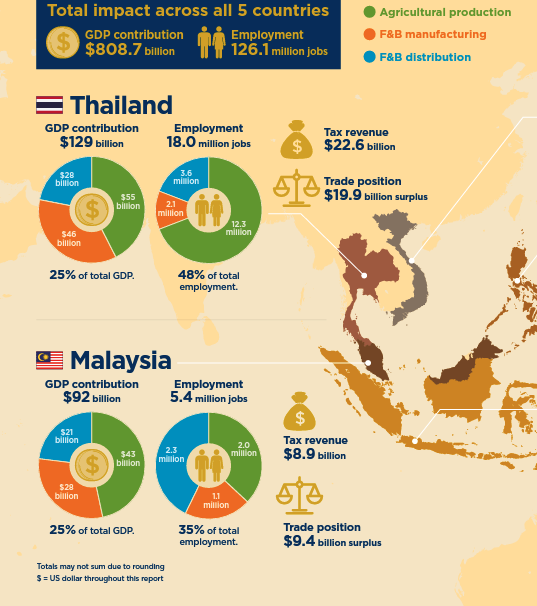A comprehensive analysis of the agricultural and food sector’s economic contribution to Southeast Asia across five key markets: Indonesia, Malaysia, the Philippines, Thailand and Vietnam, we explore the demand trends for this sector and the challenges facing it. Current and long-term global economic context
Southeast Asian economies are enjoying an economic revival in 2022 when borders reopen. Social distancing measures are lifted. and businesses Returning to more “normal” operations during the transition to a post-pandemic environment. The heart of this region’s economy is the agri-food industry. It has played a key role in the region’s recovery over the past two years of the pandemic. And it’s also at the center of future directions. This sector not only puts food on the table for the region’s massive population. But it also provides income and employment for the majority of employees and many opportunities for businesses at each stage of the agri-food value chain.
As the industry looks ahead The industry faces significant risks that threaten its growth. from inflationary pressures to demographic challenges and policy risks. The impact not only affects the livelihoods of agri-food industry entrepreneurs and employees. but also the size of the sector and its role in the supply chain. Oxford Economics has been commissioned by Food Industry Asia (FIA) to assess the full economic impact of agriculture and food in 2021 across five major Southeast Asian economies: Indonesia, Malaysia and the Philippines. Thailand and Vietnam, in doing so We have revealed the importance of the sector’s contribution to the broader Southeast Asian economy and its future path. Economic impact of agriculture and food sectors The study builds on the foundations of previous collaborations with the Asian food industry in 2021, where we redefined the agri-food sector by integrating three components of the food value chain: agricultural production; food and beverage production (F&B); and food and beverage distribution In 2021, the agriculture and food sectors contributed $808.7 billion to the five Southeast Asian countries in our study (see Fig. 1). In 2015, it actually reached 21%, the first year of our analysis.
The sector is also responsible for US$104 billion in tax revenues across five countries, the majority of which is corporate and income taxes.
in Indonesia This sector contributes $366.3 billion in 2021, 31% of GDP • In Malaysia, $92.0 billion in contributions in 2021, 25% of GDP •
In the Philippines, the agriculture and food sector contributed $126.7 billion to the economy in 2021, representing 32% of GDP.
In Thailand, this sector contributes $128.6 billion to the economy in 2021, accounting for 25% of GDP.
• In Vietnam, contributions to the economy are $95.1 billion in 2021, accounting for 26% of GDP.

The evolution of the agricultural and food sectors and the impact of COVID-19
COVID-19 pandemic affecting the agricultural and food sectors in various ways Across Southeast Asian economies according to local context and conditions in Indonesia and Malaysia The sector’s strong growth rate slowed significantly in 2020 as a result of physical distancing measures and severe travel and tourism disruptions. In Thailand and the Philippines, the sector’s economic footprint shrunk significantly that year. But it hasn’t recovered its pre-Covid value in Vietnam after expertly managing the impact of COVID in the first year. The agri-food sector’s contribution to GDP also stalled in 2021 under the exacerbating impact of the delta variable. in all Southeast Asian markets Severe and abrupt restrictions on travel and tourism have made food and beverage distribution the worst-hit part of the agri-food supply chain. The sector is making a comeback this year. With the re-opening of borders and welcoming places but in all countries in our study The economic footprint remains considerably below pre-COVID levels in 2021. In fact, the sector’s resilience throughout the pandemic
And the recovery thereafter was largely driven by agricultural production and food and beverage production. In Indonesia, Malaysia and Vietnam, their share of GDP grew steadily every year throughout the crisis in US dollars. Only in the Philippines, the economic footprint of agricultural production and food and beverage production remains smaller in 2021 than it was in 2019. Sustainable labor productivity in recent years.
Generally speaking, the sector’s share of GDP is growing rapidly compared to its relatively stable workforce base. Productivity growth is especially important in Vietnam. This is a country with traditionally the lowest GDP per worker in our study. But it’s growing fast. Southeast Asia is particularly vulnerable to the threats of climate change. especially in terms of agricultural productivity. For this reason, continuous investment in new technologies and techniques In the agricultural and food sectors, to improve productivity and sustainability of food production and distribution processes is therefore a key element of the green transition. which is recognized by the UN Climate Change Conference in 2021.
-
pakgonhttps://pakgon.com/author/pakgon/
-
pakgonhttps://pakgon.com/author/pakgon/
-
pakgonhttps://pakgon.com/author/pakgon/
-
pakgonhttps://pakgon.com/author/pakgon/




